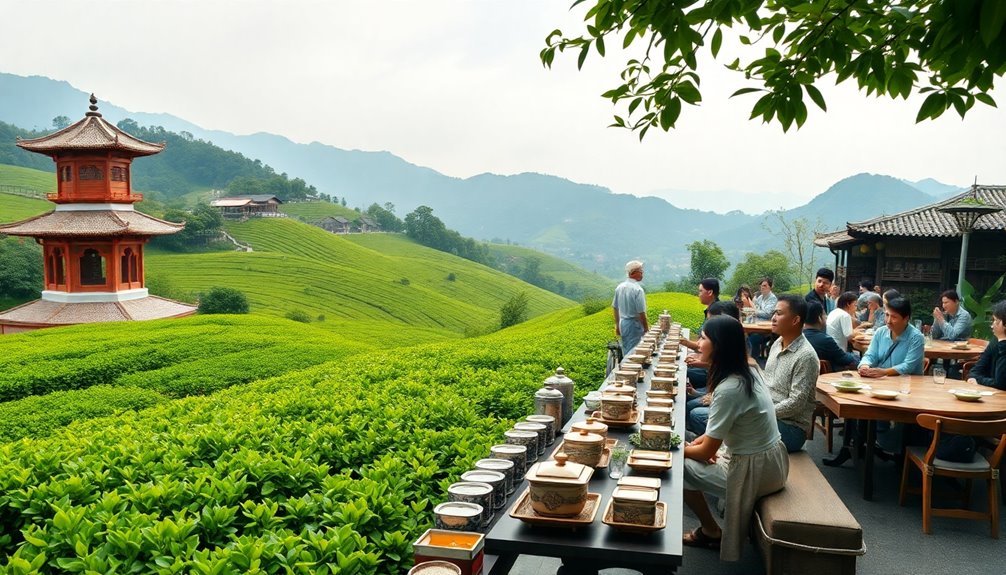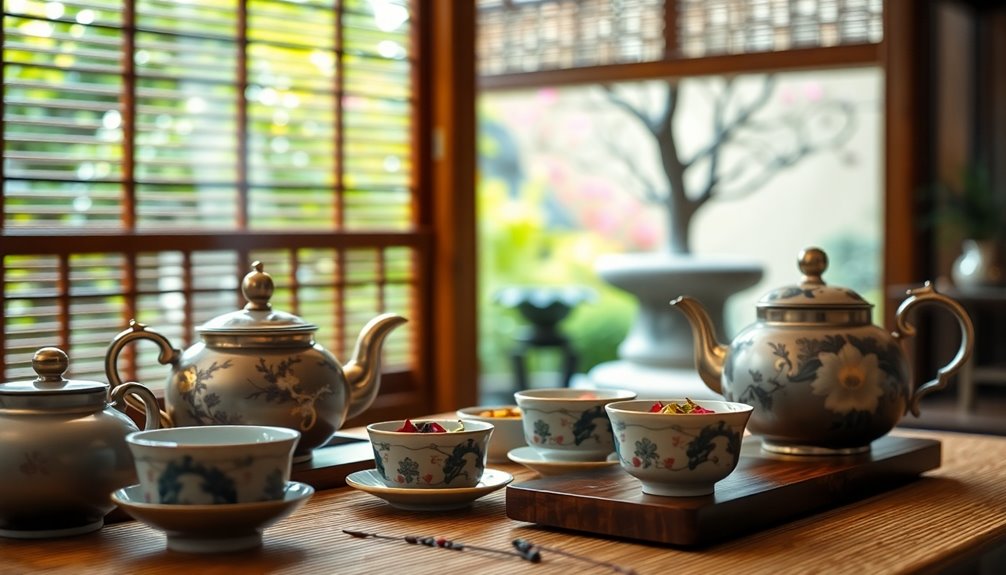You're about to explore the rich tea traditions of Asia, a journey that starts in ancient China over 4,000 years ago! Tea's cultural significance shines brightly; it symbolizes hospitality in gatherings. Each region has its unique practices, like the mindful Japanese tea ceremony or the social Indian chai rituals. Sharing tea strengthens friendships and offers a taste of history and art, seen in beautiful tea utensils and poetry. However, be aware of cultural appropriation, as many traditions should be respected. Stick around, and you'll uncover even more fascinating details about these vibrant tea customs across Asia!
Key Takeaways
- Tea originated in ancient China around 2737 BCE, marking the beginning of its rich cultural history in Asia.
- Chinese tea ceremonies emphasize the appreciation of flavor and aroma, highlighting the ritual's significance in hospitality.
- Japanese chanoyu focuses on mindfulness and tranquility, integrating tea with various art forms to enhance the experience.
- Indian chai serves as a social ritual, fostering connections and bringing people together during gatherings.
- Cultural appropriation concerns arise as traditional tea practices are misrepresented, emphasizing the need for respectful appreciation of tea's origins.
Introduction

Tea has been a cornerstone of Asian culture for thousands of years, tracing its origins back to ancient China around 2737 BCE. The story goes that Emperor Shen Nong discovered tea when leaves accidentally fell into his boiling water. Since then, tea has woven itself into the rich cultural heritage of many Asian countries.
In China, tea ceremonies showcase the art of making tea, highlighting its flavor and aroma. These ceremonies aren't just about drinking tea; they celebrate the entire process. Similarly, in Japanese culture, the chanoyu emphasizes mindfulness and beauty during tea preparation.
Every region in Asia has crafted unique tea types and methods. For example, India's spiced Chai warms the soul, while Taiwan is famous for its oolong teas. Japan offers its delightful green teas, each reflecting local traditions and tastes.
Today, tea isn't just a drink; it's a global phenomenon. With the tea industry providing jobs and generating revenue, the history of tea continues to evolve.
Innovative brewing methods and specialty tea cafes are popping up everywhere, making tea an exciting part of both traditional and modern life.
Cultural Significance of Tea

Throughout Asia, tea symbolizes hospitality and respect, serving as a vital thread in the fabric of social gatherings and cultural ceremonies. Each country has its unique tea culture that reflects its rich tea traditions.
For example, in Chinese culture, the tea ceremony emphasizes savoring flavor and aroma, showing deep respect for this ancient beverage. In Japan, the Japanese tea ceremonies, or chanoyu, have evolved over a thousand years, focusing on mindfulness and harmony, making each sip a moment of tranquility.
In India, chai—a spiced tea with milk—plays a significant role in culinary culture, fostering connections among friends and family. In Taiwan, high-quality oolong teas are celebrated for their complex flavors, with formal practices that highlight tea's cultural importance.
Tea isn't just about taste; it also offers health benefits, often used for medicinal purposes throughout Asian culture. For tea enthusiasts, understanding tea processing adds another layer of appreciation, making every cup a journey through history and tradition.
Whether you're sharing a pot with friends or enjoying a moment alone, tea remains a cherished part of life in Asia, symbolizing connection and respect.
Tea's Role in Social Rituals

In many Asian cultures, the act of sharing tea goes beyond mere refreshment; it embodies a rich tapestry of social rituals that strengthen relationships.
When you visit a home in China, you might be greeted with a warm cup of tea, symbolizing hospitality and respect. In Japan, the tea ceremony, or chanoyu, transforms tea preparation into a mindful experience, inviting connection among participants.
In India, Chai isn't just a drink; it's a social ritual brewed with spices, often shared among friends and family during gatherings. This rich tea culture fosters unity and conversation.
Similarly, Taiwanese tea ceremonies focus on aroma and flavor, turning tea-drinking into a communal experience, often accompanied by light snacks that spark dialogue.
Across Asia, tea houses serve as gathering places where you can witness these social rituals firsthand.
Whether it's the intricate Chinese tea ceremony or festive tea-drinking traditions in Sri Lanka, each practice highlights tea's role in fostering connections.
Tea's Influence on Art

The rich traditions surrounding tea extend beyond social rituals and seep into various art forms across Asia. You'll find that tea inspires incredible creativity in many ways.
In China, traditional paintings often depict tea scenes and ceremonies, showing how deeply rooted the drink is in their culture.
Japanese tea ceremonies, or chanoyu, are beautiful expressions of art that combine tea preparation with calligraphy, pottery, and flower arranging. These ceremonies reflect harmony and aesthetics, making every moment special.
The craftsmanship behind Japanese tea utensils, like matcha bowls and teapots, is truly impressive, with many considered valuable collector's items.
In India, the preparation of Chai can also be seen as an art form. Street vendors, known as chaiwallahs, use elaborate techniques to brew and serve tea, adding a lively performance to the experience.
Tea's influence stretches into poetry and literature too, where many poets reference tea as a symbol of tranquility, reflection, and social connection.
Cultural Appropriation in Tea Practices

As tea practices gain popularity worldwide, cultural appropriation becomes a pressing concern. You might notice traditional tea ceremonies, like Japan's chanoyu or China's gong fu cha, being adopted by others without full understanding or respect. This can lead to misrepresentations of these rich rituals, especially when trendy tea shops commercialize them. They often sell black tea or matcha tea without honoring the history and processing techniques behind them.
When terms like "chai" or "matcha" are misused in marketing, it overlooks the depth and significance these words hold in their original cultures. It's vital to recognize the communities that developed these practices, as they contribute so much to tea's cultural richness.
Instead of appropriating, aim for respectful cultural exchange. This means understanding the history of tea and appreciating its traditional ceremonies. You can enjoy teas from different cultures while honoring their origins.
Practical Applications

Explore the rich world of tea through practical applications that deepen your connection to its cultural roots. One way to dive in is by engaging in traditional tea ceremonies, like Japan's chanoyu. These rituals teach you about mindfulness and how tea culture enhances social interactions.
You can also participate in guided tea tastings, where you'll learn to identify different flavors and preparation techniques, helping you recognize the uniqueness of Chinese black, Japanese green, and more.
Visiting tea plantations offers a firsthand look at how tea is cultivated, connecting you to its cultural significance, especially in regions like Chengdu, China.
Don't miss workshops on tea preparation! You'll have fun learning to make Indian Chai or brew Taiwanese oolongs, gaining hands-on experience with tea's diverse culinary traditions.
Frequently Asked Questions
What Is the History of Tea in Asia?
Tea's history in Asia starts around 2737 BCE in China, spreading through Buddhist monks to Japan in the 9th century. The Tang Dynasty refined its culture, leading to diverse rituals and practices across the region.
What Is the Tradition of Tea Time?
Tea time's a cherished tradition where you gather with friends or family, enjoying tea and snacks. It's a moment of connection, relaxation, and hospitality, varying in style and timing across different cultures around the world.
What Is a Tea Journey?
A tea journey's an exploration of diverse tea cultures, where you'll taste unique flavors, participate in local ceremonies, and visit plantations. You'll gain a deeper appreciation for the craft and history behind each brew.
What Is the History of Chinese Tea Ceremonies?
Chinese tea ceremonies began in the Tang Dynasty, focusing on aesthetic enjoyment. You'll appreciate how Lu Yu's principles influenced preparation, while the Song and Ming Dynasties refined techniques, creating the mindful rituals we cherish today.
Conclusion
In conclusion, exploring the rich tea traditions of Asia opens up a world of culture and history. You've learned how tea brings people together, inspires art, and even faces challenges like cultural appropriation. Next time you enjoy a cup of tea, think about the stories and rituals behind it. Share your newfound knowledge with friends and family, and celebrate the fascinating journey of tea together. Remember, every sip can connect you to a vibrant tradition!










